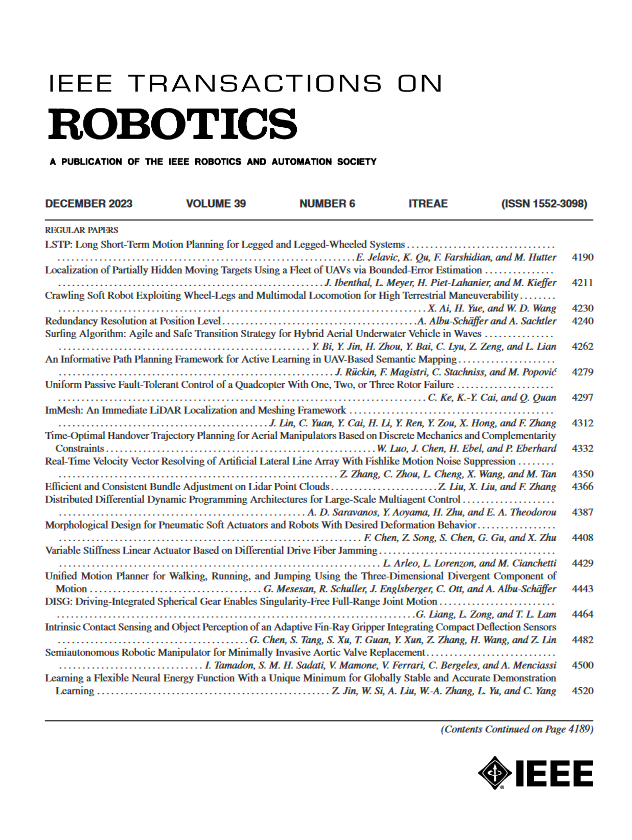CURL-SLAM: Continuous and Compact LiDAR Mapping
IF 10.5
1区 计算机科学
Q1 ROBOTICS
引用次数: 0
Abstract
This article studies 3-D light detection and ranging (LiDAR) mapping with a focus on developing an updatable and localizable map representation that enables continuity, compactness, and consistency in 3-D maps. Traditional LiDAR simultaneous localization and mapping (SLAM) systems often rely on 3-D point cloud maps, which typically require extensive storage to preserve structural details in large-scale environments. In this article, we propose a novel paradigm for LiDAR SLAM by leveraging the continuous and ultracompact representation of LiDAR (CURL). Our proposed LiDAR mapping approach, CURL-SLAM, produces compact 3-D maps capable of continuous reconstruction at variable densities using CURL’s spherical harmonics implicit encoding, and achieves global map consistency after loop closure. Unlike popular iterative-closest-point-based LiDAR odometry techniques, CURL-SLAM formulates LiDAR pose estimation as a unique optimization problem tailored for CURL and extends it to local bundle adjustment, enabling simultaneous pose refinement and map correction. Experimental results demonstrate that CURL-SLAM achieves state of the art 3-D mapping quality and competitive LiDAR trajectory accuracy, delivering sensor-rate real-time performance (10 Hz) on a CPU. We will release the CURL-SLAM implementation to the community.CURL-SLAM:连续和紧凑的激光雷达测绘
本文研究了三维光探测和测距(LiDAR)测绘,重点是开发可更新和可本地化的地图表示,从而实现三维地图的连续性、紧凑性和一致性。传统的激光雷达同步定位和测绘(SLAM)系统通常依赖于三维点云图,这通常需要大量的存储空间来保存大尺度环境中的结构细节。在本文中,我们通过利用LiDAR的连续和超紧凑表示(CURL),为LiDAR SLAM提出了一种新的范式。我们提出的激光雷达测绘方法,CURL- slam,使用CURL的球面谐波隐式编码产生紧凑的三维地图,能够在可变密度下连续重建,并在环路关闭后实现全局地图一致性。与流行的基于迭代最近点的LiDAR测程技术不同,CURL- slam将LiDAR姿态估计作为为CURL量身定制的独特优化问题,并将其扩展到局部束调整,从而同时实现姿态优化和地图校正。实验结果表明,CURL-SLAM实现了最先进的3d映射质量和具有竞争力的LiDAR轨迹精度,在CPU上提供传感器速率的实时性能(10 Hz)。我们将向社区发布CURL-SLAM实现。
本文章由计算机程序翻译,如有差异,请以英文原文为准。
求助全文
约1分钟内获得全文
求助全文
来源期刊

IEEE Transactions on Robotics
工程技术-机器人学
CiteScore
14.90
自引率
5.10%
发文量
259
审稿时长
6.0 months
期刊介绍:
The IEEE Transactions on Robotics (T-RO) is dedicated to publishing fundamental papers covering all facets of robotics, drawing on interdisciplinary approaches from computer science, control systems, electrical engineering, mathematics, mechanical engineering, and beyond. From industrial applications to service and personal assistants, surgical operations to space, underwater, and remote exploration, robots and intelligent machines play pivotal roles across various domains, including entertainment, safety, search and rescue, military applications, agriculture, and intelligent vehicles.
Special emphasis is placed on intelligent machines and systems designed for unstructured environments, where a significant portion of the environment remains unknown and beyond direct sensing or control.
 求助内容:
求助内容: 应助结果提醒方式:
应助结果提醒方式:


